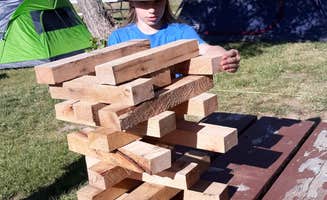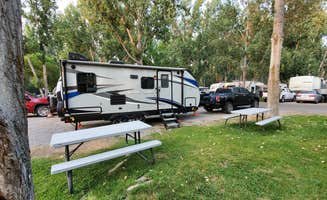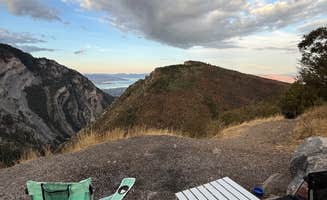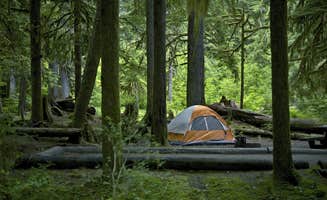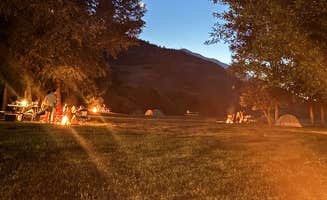Dispersed camping areas near Springville, Utah range in elevation from 4,500 to 9,000 feet, creating significant temperature variations between camping locations. The Wasatch Mountains provide a natural backdrop for campsites, with many locations situated along canyon roads that experience seasonal closures. Roads to dispersed sites often require high-clearance vehicles, especially after rain when surfaces become muddy and slick.
What to do
Hot springs hiking: 2.4 miles at Diamond Fork offers access to natural thermal pools. "I recommend visiting the Hotspring at night in the summer to escape the overwhelming crowds. There were only a handful of people at the springs during our evening visit. The trail to the springs is about 2.4 miles in," notes Carrie C.
Fishing for brown trout: Nunns Park provides riverside spots along the Provo River. "The river is right there and makes some beautiful yet subtle white noise. It is in provo canyon and the cliffs on either side are very impressive. The walk from the campsite to bridal falls is also lovely!" shares Helen A.
Mountain biking: 15 minutes from town at Payson Lakes offers network of trails. "Lots of fish in the lake, great bike trails and amazing views all around. With it being a 15 minute drive from Payson makes for a great time," reports Brad B.
Wildlife viewing: early mornings at higher elevations often reveal deer and elk. "We brought our dog who herded deer through our campsite twice, the kids loved it," mentions Veronica S.
What campers like
Isolation options: Squaw Peak Road Dispersed sites provide more privacy than developed areas. "This site is deep past the meadows near square peak. You continue to follow the dirt road in and on your left is a small depression in the land with a fire pit and ample space for tents or hammocks. This site is 400-500 yards away from the next closest collection of camp sites," explains Spencer L.
River sounds: sites near water provide natural white noise that masks road sounds. "The sound of the river was awesome!" says Shawn W. about camping near flowing water.
Lakefront access: for non-motorized boating at multiple locations. "Great fishery for children and youth, as well as an amazing area for swimming and kayaking. They do not allow motorized boats, so it is safe," notes James B.
Cost savings: free camping at dispersed sites requires no reservations. "You can stay 14 days. No permit required. No amenities," reports Aliyah B. about one free campsite near Springville.
What you should know
Weather variability: temperature drops significantly at higher elevations. "Weather can change rapidly with summer afternoon thunderstorms common," report local rangers.
Road conditions: many dispersed sites require appropriate vehicles. "Road is in ok shape. Only few places small vehicle can park. Not for RV's or larger trucks really," warns Rick W.
Insect activity: varies by location and season. "The yellowjackets were pretty annoying to deal with until after dusk and they're right back out as soon as it's light," advises Allisson G. at Hope Campground.
Bears present: in forested areas, proper food storage is essential. "Bears. Fire rings and picnic tables," notes Lynda K. succinctly about wildlife concerns.
Mud issues: after rain, many roads become hazardous. "Be wary that when it rains, this field turns into a super slick and deep mud," cautions Isabelle K.
Tips for camping with families
Covered picnic areas: provide shade and rain protection. "Each campsite had a fire ring, grill, and a picnic table. Tent sites all offered nice level areas for pitching your tent," explains Carrie C.
Educational trails: at Miner's Canyon Dispersed teach kids about local geology. "Easy drive into the area, paved road up until you turn down toward the lake. Nice gravel road for the next half mile," notes Clayton P.
Swimming access: varies by location and water quality. "This place is very cute for established camping. It has lots of trees and a nice little walking trail," reports Erin A.
Playground equipment: available at select developed campgrounds. "Good playground for the kids but the campsites themselves really don't do it," mentions Sabrina V.
Wildlife encounters: most common at dawn and dusk. "I have seen elk, deer, moose, wild turkeys, and black bear in and around the area and campsite so don't leave food in your tent," warns a local camper.
Tips from RVers
Hookup availability: varies widely between campgrounds. "Full hook-up site was surprisingly spacious with green space in-between and trees for shade," shares Mark C.
Level sites: important for larger rigs at developed campgrounds. "Paved, clean, close to shopping and gas. Nothing special. Safe," notes Peggy C.
Water access points: seasonal closures affect availability. "The water was not working at the camp the weekend we were there but we received an email from Recreation.gov the day we were supposed to arrive notifying us that it was off due to an issue," explains Sean M.
Cell service: varies dramatically by location. "Visible and Verizon pretty good," reports Kevin H., while others note complete absence of service in canyon locations.
Generator regulations: differ between established and dispersed sites. "Some great spots up the hill but you'll need high clearance and 4wd," advises Susan C. about accessing more remote locations.


